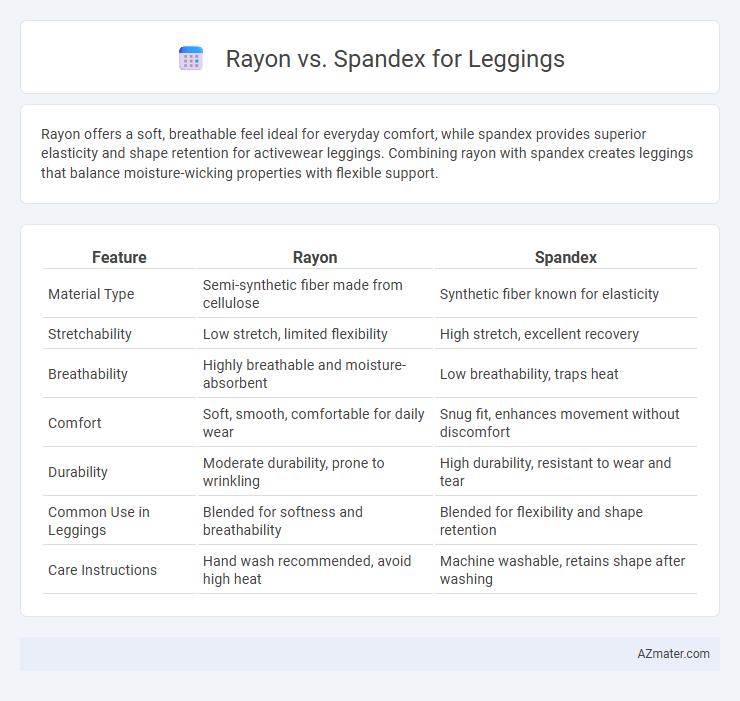Rayon offers a soft, breathable feel ideal for everyday comfort, while spandex provides superior elasticity and shape retention for activewear leggings. Combining rayon with spandex creates leggings that balance moisture-wicking properties with flexible support.
Table of Comparison
| Feature | Rayon | Spandex |
|---|---|---|
| Material Type | Semi-synthetic fiber made from cellulose | Synthetic fiber known for elasticity |
| Stretchability | Low stretch, limited flexibility | High stretch, excellent recovery |
| Breathability | Highly breathable and moisture-absorbent | Low breathability, traps heat |
| Comfort | Soft, smooth, comfortable for daily wear | Snug fit, enhances movement without discomfort |
| Durability | Moderate durability, prone to wrinkling | High durability, resistant to wear and tear |
| Common Use in Leggings | Blended for softness and breathability | Blended for flexibility and shape retention |
| Care Instructions | Hand wash recommended, avoid high heat | Machine washable, retains shape after washing |
Introduction to Rayon and Spandex
Rayon, a semi-synthetic fiber made from cellulose, offers a soft, breathable texture ideal for comfortable leggings. Spandex, known for its exceptional elasticity, provides superior stretch and shape retention, enhancing the fit and flexibility of activewear. Combining rayon's moisture-wicking properties with spandex's stretch makes leggings both comfortable and durable for everyday wear or exercise.
What is Rayon? Properties and Benefits
Rayon is a semi-synthetic fiber made from regenerated cellulose derived from wood pulp, known for its exceptional softness and breathability, making it highly comfortable for leggings. It features a smooth texture that drapes well and provides excellent moisture absorption, which helps keep the skin cool and dry during wear. Rayon leggings offer a lightweight feel with good stretchability, although they tend to be less durable and more prone to wrinkling compared to synthetic fibers like spandex.
What is Spandex? Features and Advantages
Spandex, also known as elastane or Lycra, is a synthetic fiber renowned for its exceptional elasticity, stretching up to five times its original length without losing shape. Key features include superior stretchability, moisture-wicking properties, and durability, making it ideal for leggings designed for athletic performance and comfort. Advantages of spandex leggings include enhanced flexibility, shape retention, breathability, and resistance to wear and tear, ensuring long-lasting fit and support during various physical activities.
Comfort and Wearability Comparison
Rayon leggings offer exceptional softness and breathability due to their natural cellulose fibers, making them ideal for all-day comfort. Spandex-rich leggings provide superior stretch and shape retention, enhancing wearability during physical activities by adapting to body movements. Comparing comfort and wearability, rayon leggings excel in moisture wicking and softness, while spandex ensures better flexibility and durability for active use.
Stretch and Flexibility: Which is Better for Leggings?
Spandex provides superior stretch and flexibility compared to rayon, making it the preferred choice for leggings designed to move with the body. Rayon offers a soft, breathable feel but lacks the elasticity needed for high-performance or form-fitting leggings. For optimal stretch recovery and durability, leggings with a higher percentage of spandex ensure better shape retention and freedom of movement.
Durability and Longevity of Both Fabrics
Rayon leggings offer a soft and breathable fabric but tend to have lower durability and may lose shape quickly after repeated washes. Spandex leggings excel in longevity due to their excellent elasticity and resistance to wear, maintaining fit and stretch over time. Combining rayon with spandex blends can enhance overall durability while preserving comfort and flexibility for long-lasting leggings.
Moisture-Wicking and Breathability
Rayon leggings offer moderate moisture-wicking capabilities due to their semi-synthetic cellulose fibers, but they often lack the stretch and durability needed for intense workouts. Spandex, known for its exceptional elasticity, enhances fit and movement while typically being blended with moisture-wicking fabrics like polyester or nylon to boost breathability and sweat management. For activewear leggings, spandex blends outperform rayon in moisture-wicking efficiency and breathability, making them ideal for high-intensity activities.
Care and Maintenance: Rayon vs Spandex
Rayon leggings require gentle washing in cold water and air drying to prevent shrinkage and maintain fabric softness, while spandex leggings are best cared for with mild detergents and low-heat drying to preserve elasticity. Both materials benefit from avoiding bleach and fabric softeners, which can degrade fibers and reduce garment lifespan. Proper care extends the durability and comfort of leggings made from rayon or spandex, ensuring sustained fit and performance.
Cost and Value Considerations
Rayon leggings generally offer an affordable option with a soft, breathable feel but tend to have lower durability compared to spandex blends, affecting long-term value. Spandex leggings command a higher price due to superior stretchability, shape retention, and moisture-wicking properties, making them ideal for activewear and extended use. Evaluating cost versus wear performance, spandex leggings provide better overall value for consumers prioritizing longevity and comfort in active or everyday wear.
Which Fabric is Best for Your Leggings?
Rayon offers a soft, breathable feel ideal for casual leggings, while Spandex provides superior stretch and shape retention, making it perfect for activewear. Leggings made with a blend of Spandex ensure flexibility and durability, enhancing comfort during high-movement activities. Choosing between Rayon and Spandex depends on your need for breathability versus elasticity in your leggings.

Infographic: Rayon vs Spandex for Legging
 azmater.com
azmater.com